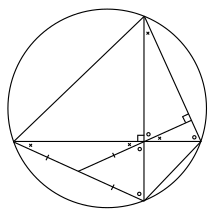308:
28:
114:
186:
564:
33:
118:
495:
483:
219:
204:
454:
559:
367:
200:
521:
307:
515:
387:
532:
479:
109:{\displaystyle {\overline {BM}}\perp {\overline {AC}},{\overline {EF}}\perp {\overline {BC}}}
214:), then the perpendicular to a side from the point of intersection of the diagonals always
355:
27:
17:
535:
553:
208:
525:
222:
540:
215:
211:
374:(i.e., they add up to 90°), and are therefore equal. Finally, the angles
293:
192:
358:
that intercept the same arc of the circle (CD). Furthermore, the angles
306:
26:
181:{\displaystyle \Rightarrow |{\overline {AF}}|=|{\overline {FD}}|}
121:
36:
180:
108:
502:. Washington, DC: Math. Assoc. Amer., p. 59, 1967
476:The Birth of Mathematics: Ancient Times to 1300
244:be four points on a circle such that the lines
252:are perpendicular. Denote the intersection of
8:
565:Theorems about quadrilaterals and circles
218:the opposite side. It is named after the
173:
158:
153:
145:
130:
125:
120:
91:
73:
55:
37:
35:
467:
457:for the area of a cyclic quadrilateral
7:
25:
478:. Publisher Infobase Publishing.
288:. Then, the theorem states that
280:be the intersection of the line
264:. Drop the perpendicular from
174:
154:
146:
126:
122:
1:
474:Michael John Bradley (2006).
429:is an isosceles triangle, so
346:, first note that the angles
354:are equal, because they are
168:
140:
101:
83:
65:
47:
409:goes similarly: the angles
272:, calling the intersection
581:
323:. We will prove that both
18:Brahmagupta's theorem
445:, as the theorem claims.
536:"Brahmagupta's theorem"
228:More specifically, let
315:We need to prove that
312:
188:
182:
110:
522:Brahmagupta's Theorem
455:Brahmagupta's formula
390:, and thus the sides
382:are the same. Hence,
331:are in fact equal to
310:
197:Brahmagupta's theorem
183:
111:
30:
311:Proof of the theorem
220:Indian mathematician
201:cyclic quadrilateral
119:
34:
516:Brahmagupta theorem
498:; Greitzer, S. L.:
533:Weisstein, Eric W.
500:Geometry Revisited
437:. It follows that
425:are all equal, so
388:isosceles triangle
313:
189:
178:
106:
496:Coxeter, H. S. M.
199:states that if a
171:
143:
104:
86:
68:
50:
16:(Redirected from
572:
546:
545:
503:
493:
487:
472:
356:inscribed angles
187:
185:
184:
179:
177:
172:
167:
159:
157:
149:
144:
139:
131:
129:
115:
113:
112:
107:
105:
100:
92:
87:
82:
74:
69:
64:
56:
51:
46:
38:
21:
580:
579:
575:
574:
573:
571:
570:
569:
550:
549:
531:
530:
512:
507:
506:
494:
490:
473:
469:
464:
451:
401:The proof that
305:
160:
132:
117:
116:
93:
75:
57:
39:
32:
31:
23:
22:
15:
12:
11:
5:
578:
576:
568:
567:
562:
552:
551:
548:
547:
528:
519:
511:
510:External links
508:
505:
504:
488:
486:. Page 70, 85.
466:
465:
463:
460:
459:
458:
450:
447:
338:To prove that
304:
301:
207:(that is, has
176:
170:
166:
163:
156:
152:
148:
142:
138:
135:
128:
124:
103:
99:
96:
90:
85:
81:
78:
72:
67:
63:
60:
54:
49:
45:
42:
24:
14:
13:
10:
9:
6:
4:
3:
2:
577:
566:
563:
561:
558:
557:
555:
543:
542:
537:
534:
529:
527:
523:
520:
517:
514:
513:
509:
501:
497:
492:
489:
485:
481:
477:
471:
468:
461:
456:
453:
452:
448:
446:
444:
440:
436:
432:
428:
424:
420:
416:
412:
408:
404:
399:
397:
393:
389:
385:
381:
377:
373:
369:
368:complementary
365:
361:
357:
353:
349:
345:
341:
336:
334:
330:
326:
322:
318:
309:
302:
300:
298:
295:
291:
287:
284:and the edge
283:
279:
275:
271:
267:
263:
259:
255:
251:
247:
243:
239:
235:
231:
226:
224:
221:
217:
213:
210:
209:perpendicular
206:
205:orthodiagonal
202:
198:
194:
164:
161:
150:
136:
133:
97:
94:
88:
79:
76:
70:
61:
58:
52:
43:
40:
29:
19:
539:
526:cut-the-knot
518:at ProofWiki
499:
491:
475:
470:
442:
438:
434:
430:
426:
422:
418:
414:
410:
406:
402:
400:
395:
391:
383:
379:
375:
371:
363:
359:
351:
347:
343:
339:
337:
332:
328:
324:
320:
316:
314:
296:
289:
285:
281:
277:
273:
269:
268:to the line
265:
261:
257:
253:
249:
245:
241:
237:
233:
229:
227:
196:
190:
560:Brahmagupta
398:are equal.
225:(598-668).
223:Brahmagupta
554:Categories
484:0816054231
462:References
541:MathWorld
370:to angle
366:are both
212:diagonals
169:¯
141:¯
123:⇒
102:¯
89:⊥
84:¯
66:¯
53:⊥
48:¯
449:See also
294:midpoint
193:geometry
292:is the
216:bisects
482:
386:is an
276:. Let
303:Proof
480:ISBN
421:and
394:and
378:and
362:and
350:and
327:and
256:and
248:and
240:and
524:at
427:DFM
423:DMF
419:BME
415:BCM
411:FDM
384:AFM
380:FMA
376:CME
372:BCM
364:CME
360:CBM
352:CBM
348:FAM
260:by
203:is
191:In
556::
538:.
443:FD
441:=
439:AF
435:FM
433:=
431:FD
417:,
413:,
407:FM
405:=
403:FD
396:FM
392:AF
344:FM
342:=
340:AF
335:.
333:FM
329:FD
325:AF
321:FD
319:=
317:AF
299:.
297:AD
286:AD
282:EM
270:BC
258:BD
254:AC
250:BD
246:AC
236:,
232:,
195:,
544:.
290:F
278:F
274:E
266:M
262:M
242:D
238:C
234:B
230:A
175:|
165:D
162:F
155:|
151:=
147:|
137:F
134:A
127:|
98:C
95:B
80:F
77:E
71:,
62:C
59:A
44:M
41:B
20:)
Text is available under the Creative Commons Attribution-ShareAlike License. Additional terms may apply.

